- Pūrongo ā-Tau 2022-23
- SECTION 1
Our year in review - SECTION 2
Making New Zealand better for New Zealanders - SECTION 3
A high-performing organisation and a great place to work - SECTION 4
Māori-Crown Relations Capability - SECTION 5
Carbon Neutral Government Programme - SECTION 6
Annual Report of the Ministry for Ethnic Communities - SECTION 7
Digital Executive Board Annual Report 2022/23 - SECTION 8
Financial and non-financial results - SECTION 9
Appendices - SECTION 10
Glossary (Appendix E)
- SECTION 1
Go to the Contents View or download the PDF version Go to the next section
4. Ngā Āheinga o te Hononga i waenga i ngāi Māori me te Karauna
Māori-Crown Relations Capability
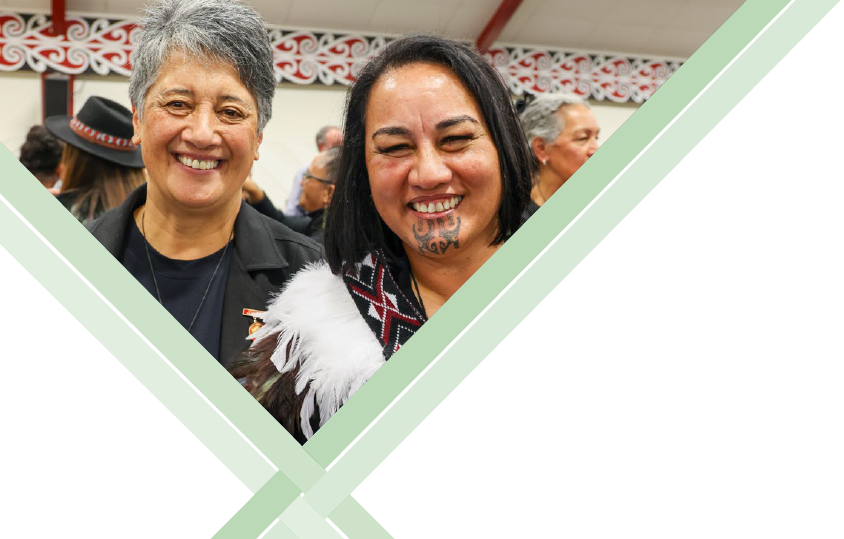
About this section
This section outlines how we are building our capability in Māori-Crown relations through a number of initiatives. These initiatives support wider public service goals of empowering our people and encouraging greater use of te reo Māori.
Ngā tīpako
Highlights
|
Ngā Āheinga o te Hononga i waenga i ngāi Māori me te Karauna
Māori-Crown Relations Capability
Our Māori strategic framework is built on fundamental principles that we have an obligation and responsibility to uphold, including kotahitanga (unity), manaakitanga (support and service), whanaungatanga (kinship and shared interests) and he tāngata (people come first).
Our partnership with Data Iwi Leaders Group: Empowering Māori Digital Aspirations through the Mana Ōrite Relationship Agreement
A Mana Ōrite Relationship Agreement was signed in June 2021 between the Data Iwi Leaders Group and the Secretary for Internal Affairs, Paul James, in his role as the Government Chief Digital Officer. It established a mana-to-mana relationship between Te Tari Taiwhenua and the Data Iwi Leaders Group.
Our partnership with the Data Iwi Leaders Group has led to significant progress in empowering Māori digital aspirations, which is guided by the Mana Ōrite Relationship Agreement through the operational arm of Te Kāhui Raraunga. This partnership has achieved several milestones in digital identity, digital inclusion and Cloud services areas which highlights the significance of this relationship, its transformational impact and demonstrates our commitment to creating a future that benefits te oranga whānui o Aotearoa. Examples include:
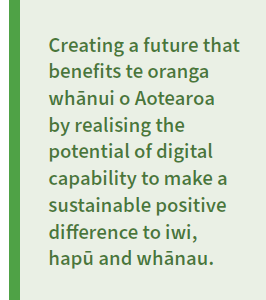
- Ensuring recognition of Te Tiriti o Waitangi, tikanga Māori and the protection of Māori data in the Digital Identity Services Trust Framework Act 2023.
- Establishing a digital identity Māori Advisory Group, which will provide advice on Māori interests and knowledge as they relate to the operation of the trust framework.
- Understanding and addressing digital inclusion barriers faced by Māori by working with the Mātauranga Iwi Leaders Group. We will continue this work so that all New Zealanders can flourish and prosper in a digital world.
- Developing the world’s first Cloud policy through the co-design process with the Data Iwi Leaders Group and other stakeholders. We recognise the importance of indigenous data interests, and this policy now mandates that agencies consider Te Tiriti-based principles when using Cloud services for Māori data.
- Developing He Aratohu Kapua Cloud Te Tiriti Guidance to facilitate collaboration between Cloud leaders and Te Tiriti partners so they can identify and engage in shared interests in Cloud and Māori data.
During the last meeting in December 2022, the Data Iwi Leaders Group acknowledged the ongoing evolution and strengthening of our relationship. We remain committed to further enhancing this partnership where we see a future through our shared priority mahi. Our collective aim is to realise the full potential of a digital evolution that makes a sustainable positive difference to iwi, hapū and whānau, where iwi-Māori thrive and te oranga whānui o Aotearoa prosper through the transformative power of digital technology.
Data for self-determination - values
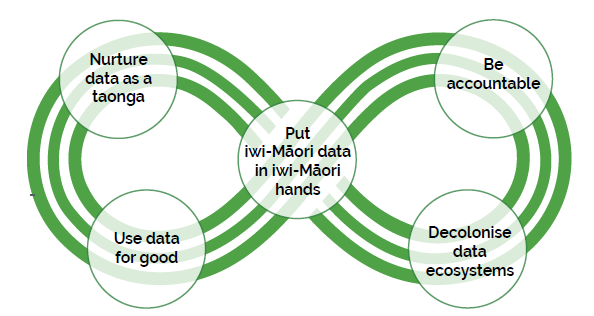
Credit: Kukutai T., Campbell-Kamariera K., Mead, A., Mikaere, K., Moses, C., Whitehead, J. & Cormack, D. (2023). Māori data governance model, Te Kāhui Raraunga
Whāinga Amorangi
The Whāinga Amorangi framework was introduced to help public service agencies develop plans to build their individual and organisational capability to engage with iwi Māori. The framework focuses on te reo Māori, the history of Aotearoa New Zealand and the Treaty of Waitangi. Outlined below are some of the initiatives at Te Tari Taiwhenua that align with the Whāinga Amorangi framework.
Establishing Te Urungi, the Māori, Strategy and Performance branch, to build leadership capability for supporting Māori and Te Tiriti outcomes
Te Tari Taiwhenua has diverse and significant responsibilities that require strong partnerships, engagement and consultation with Māori to be effective. Section 14 of the Public Service Act 2020 also recognises the role of the public service to support the Crown in its relationships with Māori under Te Tiriti. This helps Te Tari Taiwhenua to:
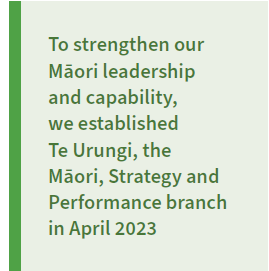
- have the right leadership in place to effectively deliver our Te Tiriti obligations
- enhance our existing roles and functions to uplift our capability which will help strengthen Māori-Crown partnerships and deliver our Te Tiriti responsibilities
- ensure a Māori perspective across and through all strategic planning, assurance and governance mahi
- support public sector expectations to better contribute and influence All-of-Government strategies and policies developed across the sector for Māori
- improve the focus on collective delivery and monitoring of outcomes for Māori, by developing a shared understanding of baselines, impacts and priorities
- ensure kaimahi Māori experience an inclusive, high-performing workplace where they are supported to perform at their best so we can make a difference for New Zealanders.
As part of the creation of Te Urungi, we recognise that we are at the early stages of growing our Māori-Crown relationships. Te Tari Taiwhenua has the privileged role of holding and protecting Te Tiriti o Waitangi. Strengthening our Māori leadership and capability will help Te Tari Taiwhenua work better as a Treaty partner and to understand Māori perspectives.
Honouring and protecting Te Tiriti o Waitangi
Ā Mātou Mahi, the organisational strategy at Te Tari Taiwhenua, honours and recognises our aspirations to protect Te Tiriti o Waitangi. Te Tari Taiwhenua provides the abilities, resources and organisational structure that are needed to strengthen our links with iwi, to protect taonga Māori and provide effective services to Māori as part of an organisation-wide strategy. Examples include:
- ‘Te Whakatinanatanga o Te Tiriti o Waitangi’, a workbook for public servants. This workbook was developed by the Public Engagement Directorate at the National Library to support learning around Te Tiriti o Waitangi and enhance our capability as public servants to uphold it in our day-to-day mahi.
- ‘E Oho! Waitangi’ kōrero series which runs at the National Library. This upholds the rich history of Aotearoa and deepens our commitment to maintaining mātauranga. There has been a rise in participation in Tiriti-based workshops and the creation of materials and resources to assist individual or branch-wide learning.
- Kāwai ki te Iwi, the Service, Delivery and Operations branch invited Dr Ingrid Huygens to conduct Tiriti o Waitangi training for kaimahi. This opportunity was also undertaken by He Pou Aronui, the Organisational Capability and Services branch.
He Waka Eke Noa – we are in this together
He Waka Eke Noa is the work programme supporting Te Aka Taiwhenua, our Māori Strategic Framework. The journey together is the foundation of He Waka Eke Noa. It speaks to the importance of all aspects of Te Tari Taiwhenua being part of the journey towards Ā Mātou Mahi, our organisational strategy.
He Waka Waka Eke Noa has three pou (or workstreams) of te reo me ōna tikanga, te ao Māori and Te Tiriti o Waitangi, which are aligned with the Whāinga Amorangi framework. The journey together will enable Te Tari Taiwhenua to:
- uplift te reo me ōna tikanga competency levels
- enhance te ao Māori capabilities that respect, value and protect mātauranga
- enable our Te Tiriti aspirations and outcomes to be met.
An important step to strengthening the Māori-Crown partnerships capability is improving our kaimahi skills in te reo Māori and tikanga Māori. Kaimahi actively participate in te reo Māori and Te Tiriti o Waitangi training workshops to improve te reo Māori, te ao Māori, and Te Tiriti skills for Te Kōtui Whitiwhiti and strengthen Māori-Crown ties.
For example, we have implemented and tailored initiatives to revitalise and elevate te reo Māori and tikanga Māori competencies among kaimahi. These initiatives support kaimahi and senior leadership in Aotearoa New Zealand and abroad. We provide both in-person and online short-term and medium-term te reo Māori, te ao Māori and Te Tiriti o Waitangi workshops, wānanga and programmes.
Honouring and embedding te ao Māori approaches
The development and embedding of te ao Māori across our core business is a key focus for Te Tari Taiwhenua. We are committed to identifying approaches that guarantee the protection and revitalisation of te reo Māori me ōna tikanga.
An increase in participation by kaimahi has been seen across Te Tari Taiwhenua in the ‘Wall Walk’ workshop. This workshop is designed to raise collective awareness of Aotearoa history and Māori-Crown relations, with a focus on improving outcomes for Māori as our Te Tiriti partners.
At Te Tari Taiwhenua, we embrace te ao Māori by normalising practices of pōwhiri, mihi whakatau and noho marae. Marae-based wānanga and workshops, Māori Leadership programmes and weekly branch waiata sessions are also commonly held across Te Tari Taiwhenua. All kaimahi also participate in celebrating Te Rā o Waitangi (Waitangi Day), Puanga-Matariki (Māori New Year) and Te Wiki o te Reo Māori (Māori Language Week).
Mataora wānanga of kaimahi
The Mataora programme is a te ao Māori initiative at Te Tari Taiwhenua designed by an external provider to enhance our cultural capability. The programme uses traditional narratives and Māori pūrākau (storytelling) to delve into stories of atua Māori (Māori deities), explore how we can apply the thinking in our daily mahi, and give effect to integrating te ao Māori practices in the workplace.
In May 2023, a wānanga was held with 25 Mataora graduates at Hinetemoa Marae, Waimarama. The wānanga provided a unique opportunity for reflection and deeper exploration. It prompted kaimahi to explore how indigenous concepts can be integrated into their mahi, offering fresh avenues to enhance our work and services. Kaimahi embraced practical experience by assisting in repairing cyclone-damaged whānau homes and papakāinga (village) in Waiohiki for a day. This provided a deeper connection to the whenua (land) and taiao (environment), with people and place, and was a glimpse into the challenges faced by communities affected by Cyclone Gabrielle, and the hīnatore (spark or potential) to overcome adversity.
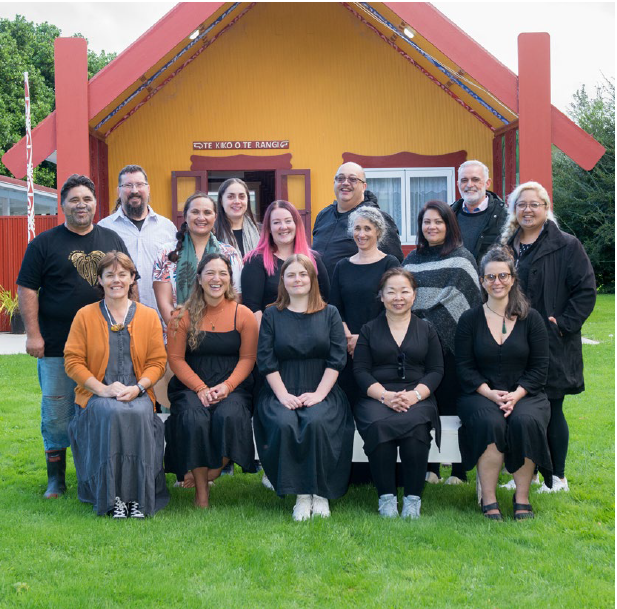
This Mataora programme was inspired by the following pūrākau of Mataora and Niwareka, which is one of many stories that bring te ao Māori perspectives to life. This tells the story of transformation and change.
The Pūrākau of Mataora and Niwareka
Mataora was a Rangatira who fell in love with the tūrehu, Niwareka. They married and for a while lived happily. Mataora was prone to fits of jealousy and one day wronged Niwareka, causing her to flee home to Rarohenga. Consumed with remorse, Mataora followed her, arriving in Rarohenga after a long and difficult journey. Once there he worked hard, learnt to be humble and eventually won Niwareka back. He also received tā moko, the permanent mark of transformation and change.
Maihi Karauna
Maihi Karauna is the Crown’s strategy for revitalising te reo Māori. Te Tari Taiwhenua has committed to support the revitalisation and use of te reo Māori across the organisation and its partners.
Examples include:
- Te Tari Taiwhenua actively gives effect to the Maihi Karauna by partnering with Te Wānanga o Aotearoa and Te Wānanga o Raukawa to enrol willing kaimahi into Level 1-4 te reo Māori courses.
- Kaimahi are encouraged to learn the pronunciation of te reo Māori, by participating in ongoing karakia and waiata workshops and attending mihi whakatau using mihimihi and pepehā and revitalising te reo Māori me ōna tikanga through Level 1-2 online sessions with Manawataki consultants.
- Te Kōtui Whitiwhiti Digital Public Service branch conducted a survey to identify competency levels of te reo Māori, which indicated that kaimahi felt levels of competency ranging from unfamiliar to comfortable. The overall feedback from the survey was to continue to increase the visibility of te reo and kaupapa Māori and this has also assisted in the development of a Matihiko Reo Branch Plan from July 2023.
- The Kāwai ki te Iwi Service, Delivery and Operations branch has undertaken a number of different initiatives to support the revitalisation of te reo Māori. These include holding noho marae over the year, using te reo Māori in wānanga and facilitating whaikōrero one-on-one sessions.
Case study
Whananaki community partnership
Our aim
Te Tari Taiwhenua partners with a number of communities across Aotearoa New Zealand to support them in achieving their aspirations for their community. This is made possible through the Hōtaka Whakawhanake e ārahina ana e te Hapori Community-led Development Programme.
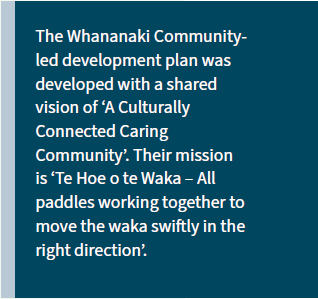
Our role
The Hapāi Hapori team within Te Tari Taiwhenua provides community development and advisory services to support hapū, iwi, community, and community organisations to support them to achieve their aspirations. This includes providing financial support through grants and connections to resources, services, other organisations, local government and central government.
The outcome
In 2017, Te Tari Taiwhenua formed a partnership with the Whananaki community. This partnership led to a Whananaki community-led development plan, which showed the positive impact of enduring and equitable partnerships with mana whenua and the wider community.
One of the recent achievements in this relationship between Te Tari Taiwhenua and the Whananaki community was the opening of the redeveloped Whakapaumahara Marae complex in April 2023. The Whakapaumahara Marae Committee and local mana whenua were an important part of the partnership, and this relationship supported the progression of the redevelopment.
We continue to partner with the Whananaki community to source funding for the planned Community Hub. This also includes supporting the sustainability initiative for the native nursery and the operation of the local community organisation that will support future initiatives.
What this means for tangata whenua and communities
These partnerships help communities’ sense of identity, cultural pride and connectedness to improve substantially. Whananaki is an inspiring example of how collaborative partnerships can support and create a more equitable and prosperous future for mana whenua and the wider community.